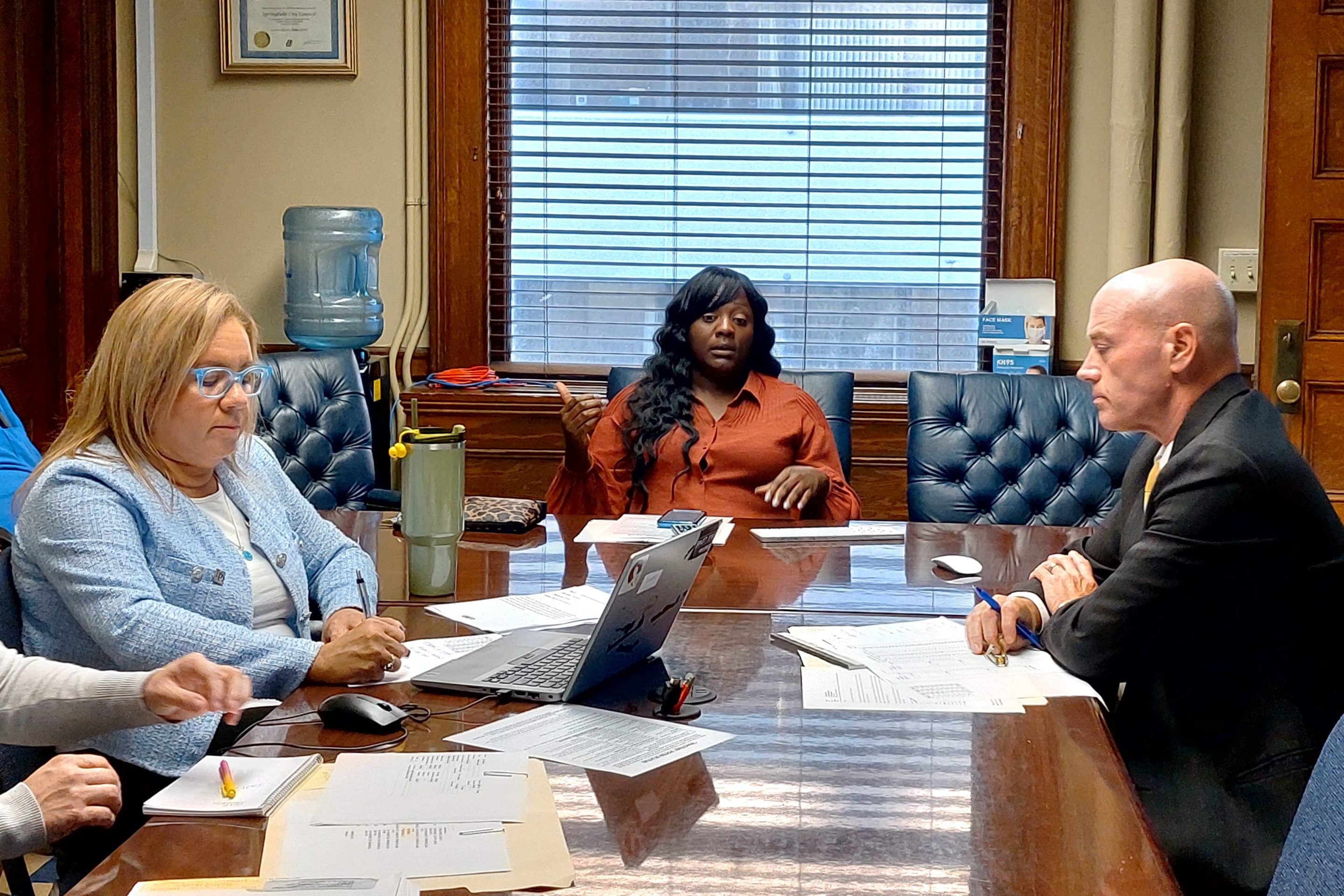City Councilor Tracye Whitfield, chair of the Subcommittee on Race and Civil Rights, leads a discussion with Elections Commissioner Gladys Oyola-Lopez and City Solicitor Stephen Buoniconti about the process of voters being listed as inactive.
Reminder Publishing photo by Sarah Heinonen
SPRINGFIELD — Three months after the Pioneer Valley Project, a Springfield-based activist organization, shared what appeared to be discrepancies between the status of voters in different city wards, the Springfield City Council Subcommittee on Race and Civil Rights conducted a meeting to discuss the data and the processes for categorizing voters.
Subcommittee Chair Tracye Whitfield began the meeting by asking City Clerk and Election Commissioner Gladys Oyola-Lopez about the process of becoming an inactive voter. Oyola-Lopez explained that prior to 2009, Springfield kept a separate list of inactive voters and when an inactive voter came to the polls, they would be directed to a separate table. She said she felt it made voters feel excluded and therefore changed the system, with the approval of the secretary of commonwealth’s office, to a single list that included both active and inactive voters.
Each year the city sends a municipal census to all residences. The names of the people living at an address must be confirmed on the census and the form should be returned by mail, although Oyola-Lopez said the information can be delivered by phone or email, as well. If a resident does not return their census, a second mailing goes out. If still not returned, the resident is marked as an inactive voter, because they may have moved.
Whitfield said voters had told her they were marked as inactive despite consistently returning their census. Meanwhile, others say they have not returned their census but remained active. “There’s discrepancy,” she said.
Oyola-Lopez said answering the census is not the only way people can remain active voters. Signing a petition or nominatION papers for a candidate for public office, both of which require the listing of an address, are considered voter activity, she said. Further, she said the databases for state agencies and connected and listing an address with one, such as the Registry of Motor Vehicles, will reflect on the voter rolls. Whitfield thanked Oyola-Lopez for the explanation.
When a person categorized as inactive comes to vote, Oyola-Lopez said poll workers are trained to ask for proof of address. It does not need to be a photo ID, she said, anything that lists a name and address is acceptable. If the person does not have proof of address or an ID, they will be allowed to vote after signing a form affirming their address. “People should never be turned away,” Oyola-Lopez said.
“The problem is, it does happen,” Councilor Zaida Govan responded.
Pioneer Valley Project Executive Director Tara Parrish said she spoke with a poll worker who told her he regularly sends people home to get their IDs. Oyola-Lopez said that contradicts the training given to poll workers. “We would never send a voter home for ID. That creates an unnecessary hardship,” she said and asked Parrish to privately share the name of the poll worker so they can be retrained.
When asked about training poll workers, Deputy Election Commissioner Shavena Martin said training is done prior to the first election of the year and before each election. She also said poll workers are urged to keep the training manual so they can reference it during elections.
Whitfield said that when she voted during the Sept. 3 primary, a man who was there at the same time was told he was no longer registered to vote in Springfield, despite showing an ID with a Springfield address. He was eventually told his address was changed by the Registry of Motor Vehicles.
Oyola-Lopez said she knew which person Whitfield was referencing and said he changed his address with his car insurance company to reflect his business in Pittsfield to save money. Not only was that insurance fraud, she said, but it led to the person’s address being updated at Registry of Motor Vehicles. The change at that state agency was then reflected on the voter rolls.
The data shared by the Pioneer Valley Project in June was acquired through a public records request and provided by the city. It showed between 3,000 and 5,000 inactive voters in Wards 1-4, while inactive voters in wards 5-8 numbered in double digits.
Oyola-Lopez said inactive voters in Springfield are 17% of the electorate. She said other communities show significantly higher percentages.
City Solicitor Stephen Buoniconti said, “We have gotten a clean bill of health from the secretary of state’s office on a yearly basis.” He went on to say that the inactive voter numbers “can look glaring” in some wards, but said there were several possible reasons for that. He asserted Oyola-Lopez had not done anything inappropriate or outside of her responsibilities as election commissioner.
Whitfield assured everyone, “No one is placing blame. We don’t have to talk about anyone’s character.” Govan shared a similar sentiment. “We’re not talking about people. We’re talking about processes. I don’t want people to think we’re criticizing people.”
Oyola-Lopez said she had requested the secretary of the commonwealth’s office send an audit of Springfield’s voter rolls for the past three years so it could be compared to the numbers presented by the Pioneer Valley Project. She suggested the data may have been misinterpreted by the organization.
Parrish said the number of inactive voters jumped in 2023 over 2022. She shared a spreadsheet with the September 2022 voter numbers at the meeting. With a total of 116,583 registered voters, the number of inactive ones was 558.
Oyola-Lopez shook her head. “There’s no way this could be correct,” she said, adding that the number of inactive voters could never be that low with an electorate of Springfield’s size. Parrish reminded her that the data came from the Election Commission.
It was noted that some data in the spreadsheet had been redacted. Election specialist Chelsea Parmentier said that public records requests are sometimes redacted by the Law Department before being sent to the requesting party.
Buoniconti explained public records requests are received by the Law Department and forwarded to the appropriate city department. The city cannot create documents in response to a request, only share existing ones. Sensitive information of those documents, such as social security numbers or police officer addresses are redacted before the documents are released.
“How the numbers got skewed, I do not know,” he said.
Parrish said it was “troubling” that the data from the public records request was inaccurate.
“How much of this is a capacity issue?” asked Councilor Jose Delgado. Oyola-Lopez said the city receives reimbursements from the state for costs incurred from early voting. That said, she added all department heads would like more money for their team.
Govan remarked that low voter turnout was a problem in the city. She and Whitfield both noted that several residents said they were not aware of the Sept. 3 primary. Oyola-Lopez said voters are mailed a postcard ahead of elections that tells them how to request a vote-by-mail ballot. She also said there were few city departments that are as engaged in community outreach as the Elections Commission.
Govan said the city must “go the extra mile” in boosting voter turnout and said the commission’s budget may need to be increased. Whitfield suggested commercials and social media to reach voters who do not read their mail.
Councilor Lavar Click-Bruce said the issue is one of awareness. “We need to have more education around this issue,” he said. He urged the Election Commission to partner with the Pioneer Valley Project to educate the public about the importance of elections and keeping voter status up to date.



